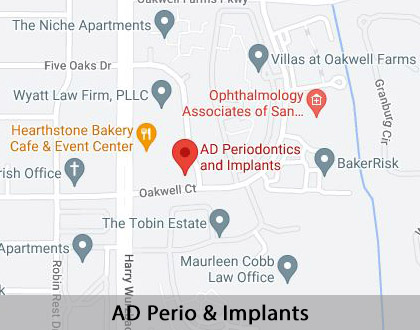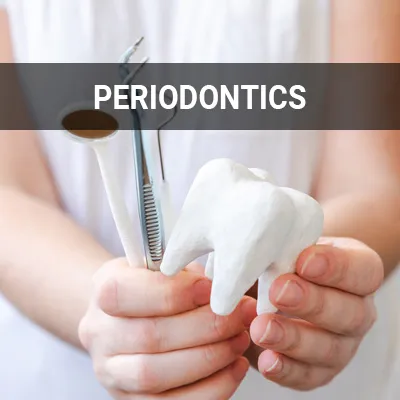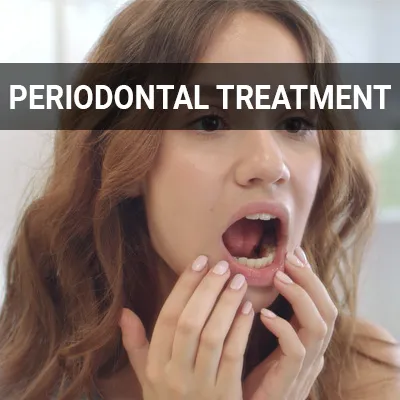Gum Dentist San Antonio, TX
A gum dentist is a dental specialist who trains primarily in diagnosing and treating all forms of gum disease, from mild gingivitis to more severe gum conditions, such as periodontitis and periodontal disease. If you have been diagnosed with a form of gum disease or suffer from swollen, tender, or bleeding gums, your next stop should be the gum dentist. This specialist also offers a broad array of additional treatments focused on the structures that support the tooth.
Treating gum disease and learning ways to keep your gums healthy is an important part of maintaining not just your oral health but your overall health as well. A gum dentist is available at AD Perio & Implants in San Antonio and the surrounding area. Call us at (210) 805-8400 to schedule an appointment.
Gum Dentist Defined
A gum dentist is a dental professional who has undergone additional education and training beyond dental school. This additional training focuses on treating gum and bone tissue diseases that support the teeth and the placement of dental implants. They are familiar with the latest techniques for diagnosing and treating gum disease and can help patients manage gum problems such as oral inflammation.
A gum dentist, called a periodontist, specializes in treating periodontal diseases. In addition to treating gums and gum disease inflammation, they can also perform cosmetic and restorative procedures to enhance a patient's smile and function. Patients are often referred to a periodontist when their gum disease has started to advance.
“A gum dentist is a dental professional who has undergone additional training beyond dental school.”
Understanding Periodontics
Periodontics is the field of dentistry interested in the structures surrounding and supporting the teeth. That includes the gums and other tooth-supporting structures known as the periodontium. This specialty focuses on the inflammatory disease that destroys the gums and these supporting structures.
The gums serve many different purposes, so keeping them healthy is vital. They not only serve as a protective layer against disease-causing bacteria but also keep the teeth in place. Without the gums, bacteria and food debris would directly line the deeper parts of the teeth.
Healthy gums usually indicate a healthy body. However, gum disease has been linked to serious health conditions, such as heart disease and stroke. In addition, when the gums are inflamed, bacteria in the mouth can enter the bloodstream more quickly, making the rest of the body more susceptible to infections.
“Periodontics is the field of dentistry interested in the structures surrounding and supporting the teeth.”
Gum Dentist Treatments
A gum dentist provides many different treatments and procedures to address and improve gum health. Depending on the severity of the patient's condition, the procedure may be surgical or nonsurgical. A periodontist will often start with the least invasive option.
One nonsurgical treatment is a deep cleaning called scaling and root planing. That is when a specialized cleaning device removes plaque and tartar from your teeth under the gum line and around the root. We smooth out the rough surface of the tooth and root, providing a healthy surface for the gums to reattach onto the tooth.
If the condition is more serious, surgery can help restore a patient's smile. Some common surgical treatments include:
- Pocket depth reduction or flap surgery: During this surgery, gum tissue gets folded back, removing bacteria along with any plaque and tartar. The remaining issue is then sewed back into place.
- Regeneration: When gum disease has destroyed bone and tissue supporting the teeth, a regeneration procedure, such as a bone graft, is needed to restore these areas.
- Soft-tissue graft: Gum recession often accompanies gum disease. During a soft-tissue graft, tissue from either the top of the mouth or another area is attached to the gum line, covering and restoring the roots.
A periodontist may also offer other services, including dental implants or cosmetic procedures. Crown lengthening often gets used for both cosmetic and restorative procedures. Cosmetically, it addresses a gummy smile by altering the outline of the gum tissue and exposing more of the tooth. In restorative procedures, it creates enough room to position a dental crown properly on the tooth.
“A gum dentist provides many different treatments and procedures to address and improve gum health.”
Check out what others are saying about our dental services on Yelp: Gum Dentist in San Antonio, TX
Why You Need a Gum Dentist
A dentist is typically the first person a patient sees for dental care. When a dentist finds symptoms of gingivitis or advancing gum disease, it may be necessary to refer the patient to a gum dentist for further treatment. Patients can also seek a periodontist for cosmetic or reconstructive procedures, such as dental implants, on their own.
Unhealthy gums can progress to the point where it hinders a patient's ability to chew and speak. In addition, untreated gum disease will eventually lead to tooth loss. Periodontal treatment helps patients improve their condition and increase their chances of keeping their natural teeth.
“Unhealthy gums can progress to the point where it hinders a patient’s ability to chew and speak.”
Questions Answered on This Page
Q. What is a gum dentist? What is a periodontist?
Q. What is periodontics? Why is gum health important?
Q. What types of treatments does a gum dentist offer?
Q. Why would I need a gum dentist?
Q. What are the benefits of visiting a gum dentist?
People Also Ask
Q. Why would I need a periodontist?
Q. What types of gum medications are there? What medications get prescribed for certain gum conditions?
Q. What are the types of periodontal procedures?
Q. What can an oral cancer screening reveal?
Benefits of a Gum Dentist
Periodontists are experts in diagnosing and treating gum disease. They stay up to date on the latest therapies and offer state-of-the-art treatments. In addition to replacing missing teeth, a gum dentist can help patients prevent tooth loss in the future with a personalized treatment plan.
Nonsurgical treatments offered by a gum dentist can quickly and effectively stop the spread of infection and restore the health of a patient's gums. Since periodontal disease is progressive, early assessment and intervention by a periodontist are critical to preserving one's smile. In addition, with help and dedication to good oral hygiene, it is easier to keep natural teeth healthy for a longer period.
“Nonsurgical treatments offered by a gum dentist can quickly and effectively stop the spread of infection and restore the health of a patient’s gums.”
Frequently Asked Questions
Q. What can gum dentists do?
A. Gum dentists specialize in the diagnosis and treatment of gum disease along with several other specialized dental procedures. For example, they can place dental implants and monitor them to check that they are working correctly. Gum dentists can also treat gum recession and cover exposed root surfaces.
Q. What conditions can a gum dentist help treat?
A. Gum dentists can perform both surgical and non-surgical treatments of the gums. Surgical treatments include flap surgery, pocket reduction surgery, bone grafts, and soft tissue grafts. Non-surgical treatments include scale and root planing, or deep cleaning. These treatments all treat gum conditions that require bacteria removal from inside or underneath the gums.
Q. What are some symptoms of periodontal disease?
A. Symptoms of periodontal disease include bleeding, swollen or tender gums, mouth pain, receding gums, loose teeth, bad breath, and mouth sores. However, gum disease can exist for a while without showing any symptoms at all. That is why it is vital to maintain regular visits with your dentist.
Q. Do I need to get missing teeth replaced?
A. Missing teeth can create many other problems. For example, it can make it harder to chew certain foods and develop issues with the alignment of the rest of your teeth. A dental implant will help improve your smile as well as the function of your teeth.
Q. Do I need to see a dentist if I visit a periodontist?
A. Regular visits with both a dentist and a periodontist will keep your oral health in top condition. A dentist can handle everyday dental issues, while a periodontist often treats more advanced cases. In addition, periodontists and dentists often work in tandem to develop a comprehensive treatment plan.
Start Feeling Better – Visit Us Today
By visiting us as soon as possible, our team can help get you the professional treatment you need. Instead of waiting around and allowing the symptoms to get worse, we can provide you with treatment options.
Definitions
Visit a Gum Dentist Today
Gum dentists have the training and expertise needed to address all forms of periodontal disease. Do not hesitate to have your gum health addressed. The earlier gum issues get diagnosed and treated, the better your outcome. Call AD Perio & Implants at (210) 805-8400 to schedule an appointment.
Helpful Related Links
- American Academy of Periodontology (AAP). American Academy of Periodontology (AAP). 2023
- Center for Disease Control and Prevention (CDC), Periodontal Disease Page. Center for Disease Control and Prevention (CDC), Periodontal Disease Page. 2023
- WebMD, What Is a Periodontist?. WebMD, What Is a Periodontist?. 2023
About our business and website security
- AD Perio & Implants was established in 2020.
- We accept the following payment methods: American Express, Cash, Check, Discover, MasterCard, and Visa
- We serve patients from the following counties: Bexar County, Kendall County, Comal County, and Guadalupe County
- We serve patients from the following cities: San Antonio, Alamo Heights, Terrell Hills, Universal City, Boerne, Stone Oak, New Braunfels, Bulverde, Fair Oaks Ranch, Garden Ridge, Selma, and Castle Hills
- Norton Safe Web. View Details
- Trend Micro Site Safety Center. View Details
Back to top of Gum Dentist







